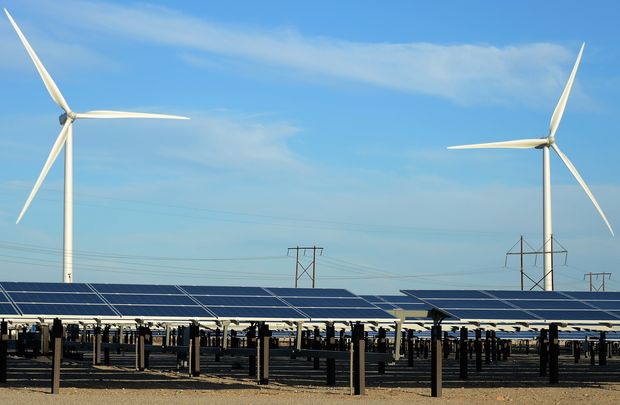
Giant wind turbines are powered by strong winds in front of solar panels in Palm Springs, Calif.
Getty Images
The U.S. will transition to a clean-energy mix regardless of who wins the White House. But the pace of that change, and with it, the toll on the environment in the meantime, could look dramatically different depending on the election outcome.
Sasha Mackler, energy project director for the Bipartisan Policy Center says “the trends in the power sector really demonstrate that this is the part of our economy that is furthest along in the energy transition.”
That’s in large part as solar and wind have become more cost competitive, and as avenues such as green hydrogen, while still expensive relative to other power sources, are gaining traction in Europe.
“The federal government could make that transition happen more quickly if it had a unifying, coherent policy framework for the power sector,” said Mackler, in a report by S&P Global Platts Analytics. The election is “really more a question of time, rather than endpoint, when it comes to electricity,” whereas “the other parts of the economy are going to be more difficult” to transition to a low-carbon future. Analysts typically point to transportation as a case in point.
Read: IEA crowns renewables ‘new king’ of world electricity markets as oil demand will flatten by 2030
S&P Global Platts Analytics’ expectations for the next few years include a brief rebound in coal as demand and supply are better aligned. Coal is the fading sector of the economy that President Trump pledged to save during the last election even as coal operators themselves had already been closing or migrating to other sources.
The Platts forecast includes a pullback in natural gas, the electricity source that has logged an historic cost drop and increased U.S. energy independence. Natural gas’s NG00, +0.28% inclusion in a mix of traditional and new energy sources is at the center of most Republican-led energy plans, alongside solar, wind, green hydrogen and more.
By 2030, coal’s current 21% share of the generation mix would be closer to 5%, under a reference case that assumes a federal carbon price starting in 2026, Platts says. Wind and solar generation in that scenario is seen increasing from 11% of the generation mix in 2020 to 30% in 2030.
Christine Tezak, a managing director at research firm ClearView Energy Partners, said the energy transition was “clearly moving forward on a regional basis,” without endorsement at the federal level under Trump. A federal government helmed by Biden could speed up the transition assuming a new makeup at the Federal Energy Regulatory Commission will be more receptive and supportive of state initiatives to incrementally green their portfolios through the wholesale power markets.
Read: Fracking and the ‘Green New Deal’ — Here’s where Trump and Biden stand on climate change
Progress toward a green-energy mix under Biden can only be speculated and will hinge on the Congressional makeup. A Biden win combined with a “blue wave” giving Democrats control of Congress increases chances for consideration of greenhouse gas legislation aimed at the power sector, Tezak said. But getting a climate bill through Congress on a narrow Senate majority, if Democrats take over, is “probably a long shot,” due in part to expectations that recovering from the coronavirus pandemic and the economic dislocation associated with that crisis will be top of mind, she told Platts.
Biden’s four-year, $2 trillion climate plan seeks to decarbonize the power sector by 2035 and reach net-zero emissions across the entire economy by 2050. He wants to expand electric vehicle charging infrastructure and make efficiency upgrades to buildings. His approach generally aligns with the push of congressional Democrats on the issue, although Biden has said in his campaign that his will not eliminate fossil fuels CL00, +1.83%, including the use of fracking, right away.
A continuation of fossil fuel-friendly policies at the federal level may be expected with a Trump win. But such an outcome is not expected to scuttle price-driven changes that have allowed natural gas, wind and solar to gain market share, said Benjamin Salisbury, director of research and senior policy analyst at Height Capital Markets.
Some analysts turned to the Trump administration’s trade and tariff record to sketch out what may take shape in the energy space.
Earlier this month, the executive branch made a proclamation regarding U.S. tariffs on imported solar panels for a preview of what could be expected in a second term.
That proclamation revokes an exemption for bifacial solar panels and moves to raise the rate of the import tariff in 2021 to 18% from the originally planned 15%. The tariffs can be extended four years beyond the 2021 term.
Jeff Berman, Platts Analytics’ director of emissions and clean energy analytics, says Trump could also serve a blow to renewable deployments through his authority over the Committee on Foreign Investment in the U.S., “the obscure but powerful government body used to block a Chinese company’s acquisition of the video-sharing app TikTok.”
A judge eventually blocked the Trump administration’s ban for now.
Trump could potentially turn to CFIUS “to block offshore wind investment, given the fact that a lot of the major players in the offshore wind industry are companies that have some degree of state ownership,” Berman added.
Some analysts expressed their belief that Trump could read the market tea leaves, even as the fossil fuel lobby remains strong.
The right-leaning Citizens for Responsible Energy Solutions says its polling shows Republican voters joining Democrats and independents in wanting the government to address climate change and the environment.
“Republican voters want market-driven efforts that diversify our energy supply and promote good clean energy jobs, particularly in this moment,” said Heather Reams, executive director at CRES.
Some 67% of Republican and Republican-leaning voters agree making investments in clean energy are important to our nation’s effort to rebuild the economy after the coronavirus shutdown, the CRES poll indicates. Three-quarters of respondents support federal action to accelerate the development and use of clean energy in the United States.




